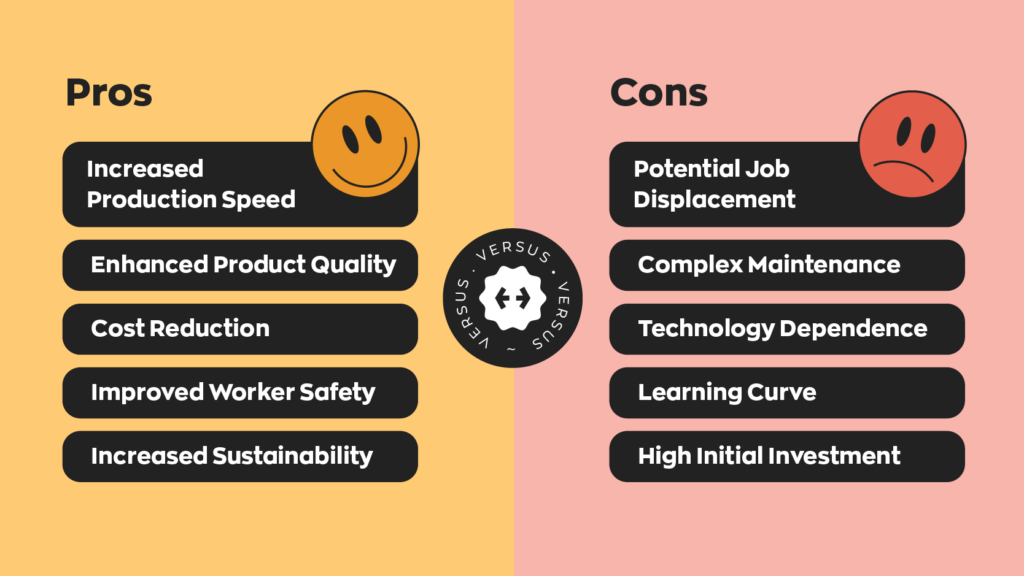Automation is becoming increasingly important in the manufacturing sector. A survey by Deloitte found that 62% of manufacturers planned to use robotics and automation to improve efficiency in 2023. In addition to increasing efficiency, companies are investing in automation to cut costs and deal with labor shortages.
The growth of automation is occurring at the same time as another trend: an increased interest in sustainability. According to a 2022 survey by the National Association of Manufacturers (NAM), 58% of manufacturers believe sustainability is essential to remain competitive, and 68% planned to implement sustainability practices in their companies.
Automation is key to increasing efficiency and minimizing carbon emissions. Industry accounts for about one-third of all CO2 pollution. Automated processes can reduce energy consumption and help companies collect data to further increase their sustainability.

Reducing energy consumption
Energy use is the primary cause of carbon emissions in manufacturing. Therefore, reducing power consumption can increase sustainability.
Technologies like automation and artificial intelligence (AI) can help reduce energy usage. Here’s how:
- Smart sensors can help control machinery and processes to limit energy consumption. For instance, sensors connected by cellular or Wi-Fi can automatically turn off machines that are not in use. These devices can also collect data that measures efficiency, giving operators the insights to adjust settings to limit energy use.
- Computer vision can monitor inventory, products, and processes without sensors. It can assess production and find motions, operations, or products that do not fit within acceptable time, quality, or quantity limits. This constant checking of processes, inputs, and outputs allows managers to spot problems early.
- Machine learning algorithms can assess data points from around a factory and find energy use patterns. It can then evaluate these to see if they match patterns for optimal energy consumption.
- Automated machinery has fewer variables than human-controlled machinery. Technicians can set machines to work at peak efficiency and deliver consistent results. In other words, the machines have maximum output while using as little energy as possible.
Chinese steel company CITIC Pacific Special Steel is an example of this type of tech-powered energy use reduction. It has adopted AI applications that collect data from blast furnaces and use it to optimize processes. The change allowed the producer to increase output by 15% while decreasing energy use by 11%.
Decreasing material wastage
Scraps, byproducts, and surplus materials from manufacturing can impact the environment. For example, this waste may end up in landfills. In addition to taking up space, some of these materials can cause environmental issues. For instance, metals can seep into the water table and contaminate the water supply.

Also, carbon gets produced when materials are extracted or produced and transported to the factory. If you make a surplus of finished products, you’ll need to dispose of them. The same goes for any unused raw materials. Transportation to a landfill and recycling center causes further carbon emissions. These carbon emissions were entirely avoidable since none of the items were used.
A manufacturer can reduce these types of wastage with automation. Here are three ways technology can reduce excess materials and products:
- Inventory control software, computer vision tools, and AI-powered analytics can provide real-time insights into inventory status at a factory. This can help the company avoid surpluses of materials or products.
- Demand forecasting tools can use data from current trends, markets, and consumer research to predict the sales levels for certain products. These data-powered predictions are helpful because they allow companies to meet coming demand without overproducing and creating surpluses.
- Just-in-time (JIT) production methods involve creating products when the customer needs them. This eliminates the need to guess future demand. However, it requires careful planning and supply chain management.
Toyota actually pioneered JIT production in the 1970s. The company relies on timing, automated supply tracking, and careful project management to ensure workers at each step in production have the necessary parts to complete their portion of the vehicle before moving it onto the next stage.
Maintaining cleaner air and reducing pollution
Automation can reduce materials waste, and it can also lower emissions. Manufacturing accounts for 12% of greenhouse gas emissions in the U.S., so that reduction can have a significant impact on the environment and global warming.

Here’s how automation helps maintain cleaner air by reducing emissions during manufacturing:
- Industrial robots can increase efficiency. These systems can be programmed to produce items with the minimum amount of movement. This limits the amount of carbon-producing energy needed during production. Also, robots can reproduce the same movements indefinitely, meaning there are no inconsistencies or lapses that could lead to increased energy demands.
- Automated systems for handling hazardous materials can reduce the risk of spills or contamination. Robotic equipment can handle chemicals in an enclosed environment, which can limit the risk of leaks or spills contaminating the environment surrounding a factory or plant.
- Automated air quality monitoring can collect data on emissions from a manufacturing operation in real-time. Companies can make adjustments if they receive alerts about increased emissions of carbon or other pollutants. Such a system can help them stay within acceptable emissions limits.
Energy company Shell uses robotic equipment to check emissions at refining facilities and search for leaks from the air or underwater during oil extraction operations.
Streamlining operations for efficiency
Efficient manufacturing operations can minimize waste and emissions while using less energy. Combining various automated systems can help bring about these benefits, improving your company’s bottom line and increasing employee well-being and job satisfaction.
A manufacturing software platform can combine streamlined processes to create a more efficient operation overall. This combination is important. An efficient supply chain and inventory management system is useless without good production planning and demand forecasting. Good software allows you to track every aspect of the operation automatically. If there are weak points, bottlenecks, or inefficiencies, they will become evident in the data collected from the platform.
Employees may be concerned about automation taking jobs. However, improved workflow can actually enhance employee well-being. With automated systems collecting data, providing insights, and handling repetitive manual tasks, workers are free to perform higher-level jobs that require skills and creativity. This makes for more rewarding professional opportunities and a safer, less physically demanding workplace.

Computer chip maker Intel is heavily invested in manufacturing automation. The company uses automation at its manufacturing facilities to improve quality and energy efficiency. It’s also teaming with specialized companies in Japan to automate additional processes, like packaging, which could further streamline its operations. These efforts are part of the company’s goal to achieve carbon neutrality by 2040 and cease producing landfill waste by 2030.
Increased automation can bring multiple benefits to companies in the manufacturing sector. Not only can it cut energy costs and increase productivity, but it can also enhance sustainability efforts in various ways. The increased importance of sustainability in manufacturing makes the relationship between factories and automation even more vital.
How inFlow helps automate your manufacturing business
Automation is all about removing simple menial tasks. This will free up more time for your employees to do more complex, sophisticated things that will help improve your business. Manufacturers worldwide use our software, inFlow, for just that. Automation.
Our software has various features every manufacturer needs, like kitting and bundling, manufacture orders, work orders, bill of materials, reorder points, barcodes, and more. Not only are we packed with features, but we offer all that at a fraction of the cost of other ERP systems!
Give inFlow a try, and see why so many manufacturers use our software to automate their business processes.






Great Insights!
Hey Devanshu,
Thanks for reading!
Cheers,
Jared